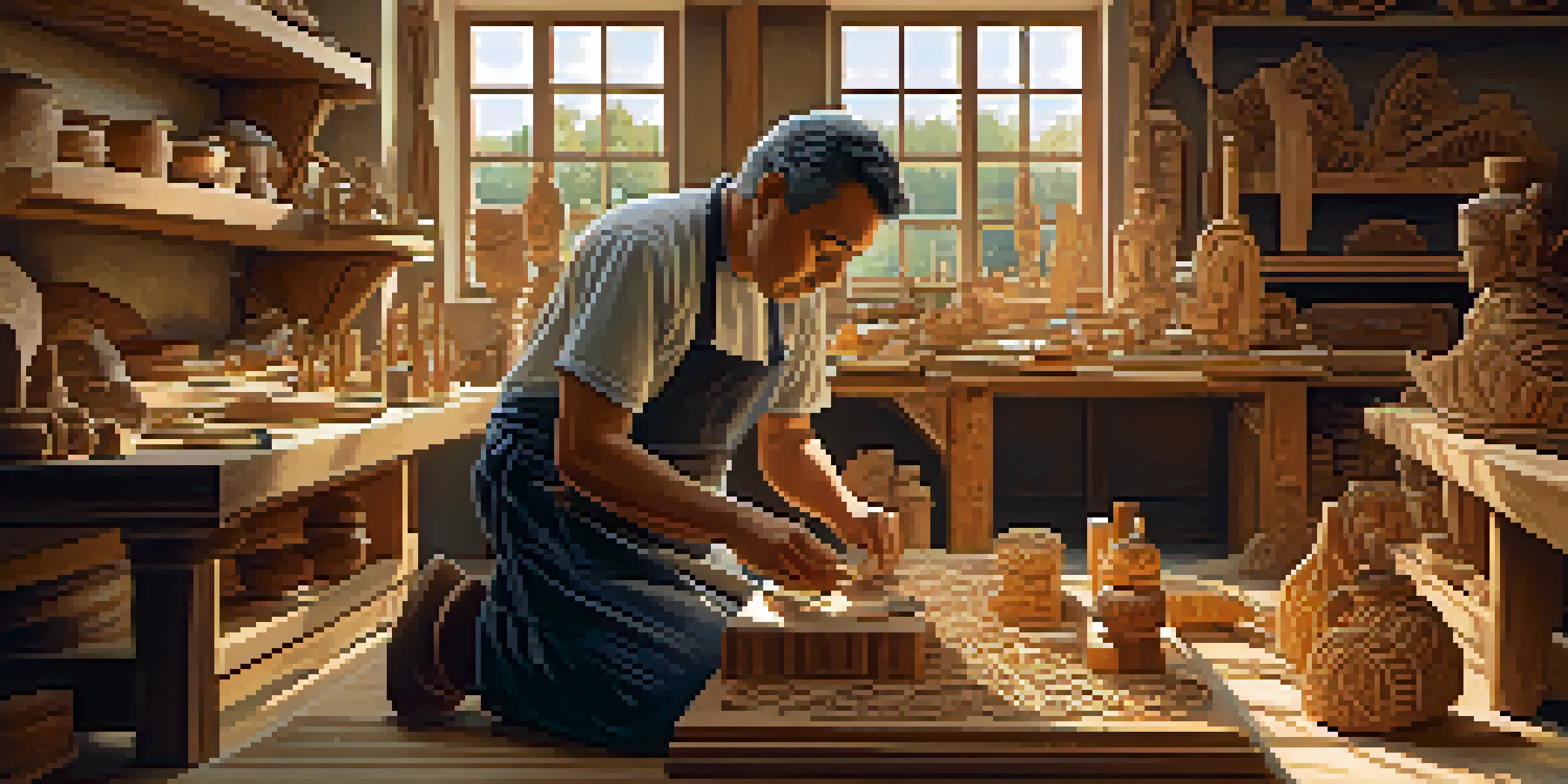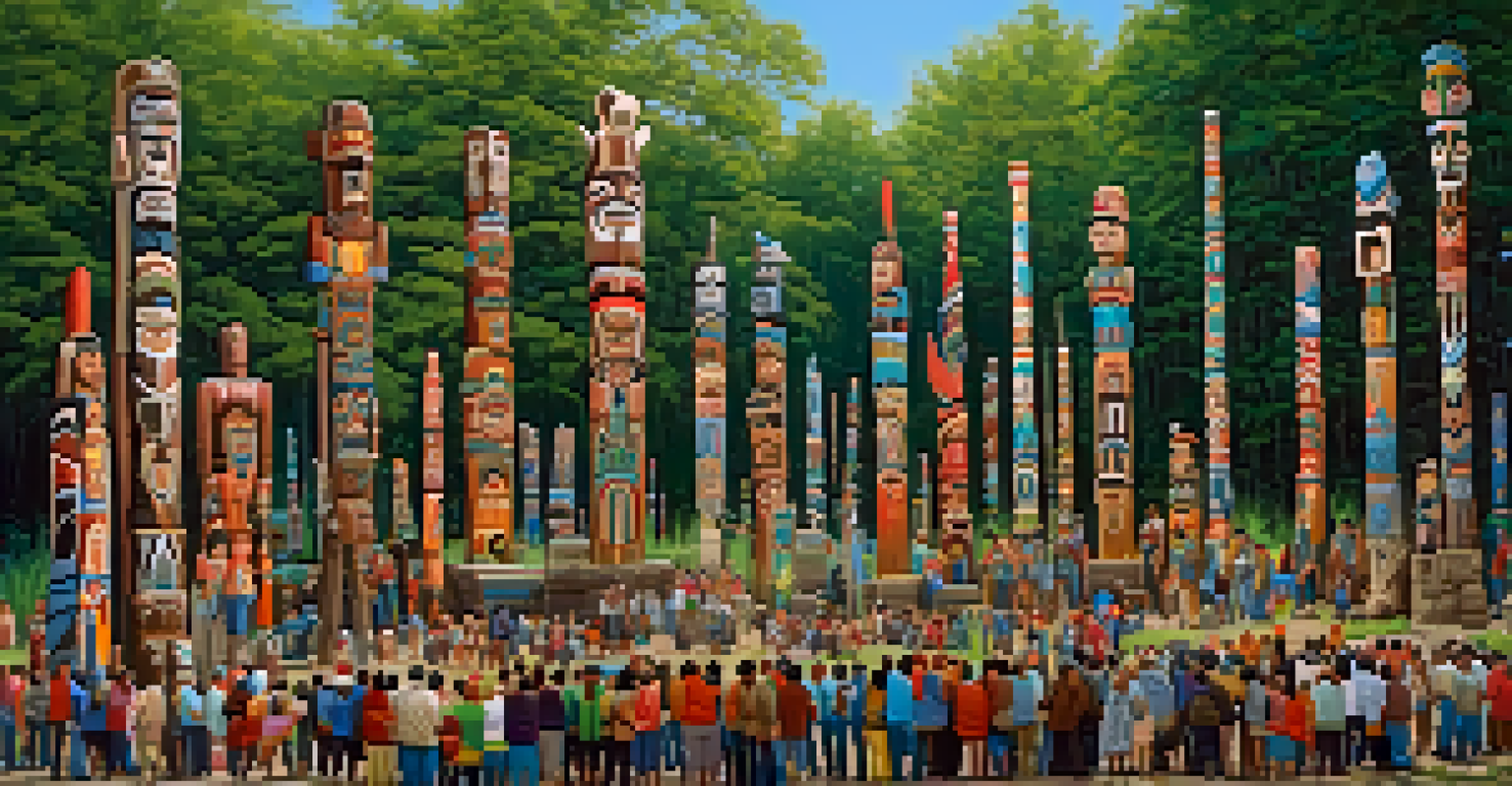Cultural Significance of Carving Techniques in Restoration

The Role of Carving in Cultural Heritage Restoration
Carving techniques play a vital role in restoring cultural heritage, as they help preserve the artistry and history embedded in objects. From ancient sculptures to modern artifacts, the intricacy of carving can reveal insights into the culture it represents. Restorers use these techniques to recreate original designs that have been lost over time, ensuring that the cultural narrative continues to be told.
The greatest art is the art of living, and living is the constant restoration of our past.
For instance, consider the restoration of a decaying wooden sculpture. By studying the original carving patterns and materials, restorers can replicate the craftsmanship that reflects the artist's intent and the era's aesthetics. This meticulous process not only honors the original work but also educates future generations about its significance.
Moreover, the act of carving in restoration reinforces the connection between the past and the present. It allows communities to engage with their heritage, fostering a sense of pride and identity. As a result, the tradition of carving becomes a living practice, intertwining history with contemporary culture.
Traditional vs. Modern Carving Techniques
When it comes to restoration, traditional carving techniques often take precedence due to their authenticity and cultural relevance. These techniques, passed down through generations, embody the skills and philosophies of the artisans who created them. By utilizing traditional methods, restorers ensure that the finished product is not only visually accurate but also culturally significant.

On the other hand, modern carving techniques introduced new tools and materials that can enhance precision and efficiency. While these innovations can be beneficial, they may sometimes lack the soul that traditional methods carry. Striking a balance between the two can lead to a restoration that respects the original while embracing contemporary advancements.
Carving Preserves Cultural Heritage
Carving techniques are essential for restoring cultural artifacts, ensuring that the artistry and historical narratives are passed down through generations.
Ultimately, the choice between traditional and modern carving techniques comes down to the specific needs of the restoration project. Each method offers unique benefits and considerations, making it essential for restorers to evaluate their options carefully.
Preserving Cultural Identity through Carving
Carving techniques are not just about aesthetics; they are a means of preserving cultural identity. Each culture has its own distinct carving styles that reflect its values, beliefs, and history. By restoring these carved elements, we help maintain the cultural narratives that shape communities and foster understanding across generations.
Heritage is our legacy from the past, what we live with today, and what we pass on to future generations.
Take, for example, the intricate wood carvings found in indigenous cultures. These carvings often tell stories, represent spiritual beliefs, or signify important events. By carefully restoring these works, we ensure that the stories they convey remain alive, even as the physical materials age.
The act of restoration thus becomes a collaborative effort, involving not just artisans but also community members who share a deep connection to the heritage. This inclusion reinforces the importance of cultural identity and encourages a collective responsibility to preserve it.
Challenges in Carving Techniques for Restoration
Restoring carved elements presents a unique set of challenges that require skill and sensitivity. One of the primary difficulties is matching the original materials and techniques used, as they may not be readily available. This can lead to compromises that might affect the integrity of the restoration.
Additionally, restorers often face the dilemma of whether to restore an object to its original state or preserve evidence of its history, such as wear and tear. This decision can be contentious, as it speaks to the broader philosophical questions about authenticity and value in cultural heritage.
Balancing Tradition and Innovation
Restorers must navigate the choice between traditional and modern carving techniques to achieve authenticity while enhancing precision.
Ultimately, the challenge lies in finding a solution that respects the original work while providing a sustainable path for future generations. Through careful consideration and collaboration, restorers can navigate these challenges effectively.
The Emotional Impact of Carving Restoration
The process of restoring carved elements often evokes strong emotions, both for the artisans involved and the communities they serve. For many, these carvings are not just objects; they are symbols of their heritage and identity. Restorers often feel a deep responsibility to honor the original artists and the stories behind their work.
Communities also experience a sense of renewal and connection when they witness the restoration of cherished artifacts. This emotional response can be incredibly powerful, as it reinforces the value of cultural heritage in their lives. Restorations can spark conversations, inspire pride, and even lead to revitalization efforts within the community.
Thus, the emotional impact of carving restoration extends far beyond the physical object. It serves as a reminder of the importance of preserving history and the connections we share through our collective narratives.
Case Studies of Successful Carving Restoration
Examining successful case studies of carving restoration can provide valuable insights into best practices and innovative techniques. For instance, the restoration of a historic cathedral's wooden altar involved an intricate process of analyzing existing carvings and recreating missing elements. This project not only restored the beauty of the altar but also revived community interest in their local history.
Another example is the restoration of indigenous totem poles, which often face deterioration due to environmental factors. By employing traditional carving techniques and sustainable materials, restorers managed to breathe new life into these symbols of cultural significance, allowing them to stand as proud representations of heritage.
Restoration Fosters Community Connection
The restoration of carved elements not only revives physical artifacts but also strengthens community ties and cultural identity.
These case studies highlight the importance of collaboration among artisans, historians, and community members. By sharing knowledge and expertise, they can achieve remarkable outcomes that honor the past while inspiring future generations.
The Future of Carving Techniques in Restoration
As we look ahead, the future of carving techniques in restoration is likely to be shaped by advancements in technology and a growing appreciation for cultural preservation. Innovations such as 3D scanning and printing are opening new avenues for restorers, allowing them to create precise replicas of lost or damaged carvings. This technology not only enhances accuracy but also makes restoration more accessible.
However, it's crucial to strike a balance between technology and traditional craftsmanship. While modern tools can aid the process, the heart of carving lies in the hands of skilled artisans who bring their unique perspectives and creativity to the table. Thus, a hybrid approach that honors both traditions will likely emerge as the best path forward.

Ultimately, the future of carving techniques in restoration will depend on our collective commitment to preserving cultural heritage. By fostering collaboration and innovation, we can ensure that the stories carved into our history continue to inspire and educate for years to come.